It probably dates back as early as the time of Leonardo da Vinci (Vinci, 1452 - Amboise, 1519) to use the term “Last Supper” as a metonymy to refer to the work the great artist painted on the wall of the refectory of the convent of Santa Maria delle Grazie in Milan, the best-known masterpiece of his long Milanese sojourn (which lasted from 1482 to 1499), and today the main evidence of Leonardo’s activity in the city. Scholar Stefano L’Occaso has recently explained that, already in 14th-century Tuscany, Domenico Cavalca used the term to refer both to the scene of theLast Supper that Jesus consumed with his apostles and to the refectory of a monastery. And Giorgio Vasari also systematically uses the term “Cenacle” in both meanings. And there are also contemporary attestations to Leonardo. L’Occaso points to two: the description, in 1499, of “1 quadretto con 1 cenacolo” in the house of the Florentine Andrea Minerbetti, and the commission, in Milan in 1506, of “uno cenacolo in tella” (i.e., on canvas) to Leonardo’s Marco d’Oggiono by Gabriel Gouffier, dean of the chapter of the cathedral of Sens in France (this was a copy of Leonardo da Vinci’sLast Supper, now preserved at the Musée National de la Renaissance in �?couen).
Whatever you want to call it, the importance and innovativeness of this work was already widely praised by Leonardo’s contemporaries. The great mathematician Luca Pacioli (Borgo Sansepolcro, c. 1445 - Rome, 1517), the first to comment on the work, wrote in the dedicatory letter of his 1498 De Divina Proportione (a date that also provides a fundamental terminus ante quem for defining the chronology of the Last Supper, since, as will be seen, there are no certain documents with dates) that “It is not possible with greater care alive the apostles imagine at the sound of the voice of the ineffable truth and when he said ’Unus vestrum me traditurus est’. Where with acti and gestures the one and the other, and the other with the one with viva and afflicta admiratione they seem to speak to each other.” TheLast Supper had impressed contemporaries with the optical illusions with which Leonardo had depicted space, with the motions of the soul that animate the figures of Christ and the apostles, and with the painter’s ability to flesh out the biblical episode with a realistic and striking scene.
But it is also a great masterpiece of artifice, as Martin Kemp, one of the leading Leonardist scholars, has well explained, according to whom certain factors such as narrative ability, psychological introspection and coloristic skill “communicate the feeling that we are looking at a depiction of a natural phenomenon endowed with supreme rationality. This is undoubtedly the impression Leonardo wanted to create, and it corresponds to the effect that his contemporaries registered. But when we analyze the structure of this painted illusion, we find the unexpected extremes of artifice and visual paradox.” For example, the fact that the length of the table is not suitable to accommodate all twelve apostles on one side: there is no room for each of them, and some disciples, such as Peter and Thomas, in a real space would have nowhere to sit. But to achieve the narrative effects he was aiming for, Leonardo was forced to the solution of grouping the apostles at the expense of the logicality of their arrangement around the table. Then again, the point of view is illogical: “Looking at the table,” Kemp notes, “we should see nothing of its surface, nor should we see much of the bodies of the disciples. The viewpoint of the painting is an impossible position at twice the height of a man” (a realistic viewpoint, according to Kemp, given the height of the wall would in fact have compromised narrative requirements). Partly by virtue of these devices, Leonardo’s Last Supper is one of the most advanced achievements of its time.
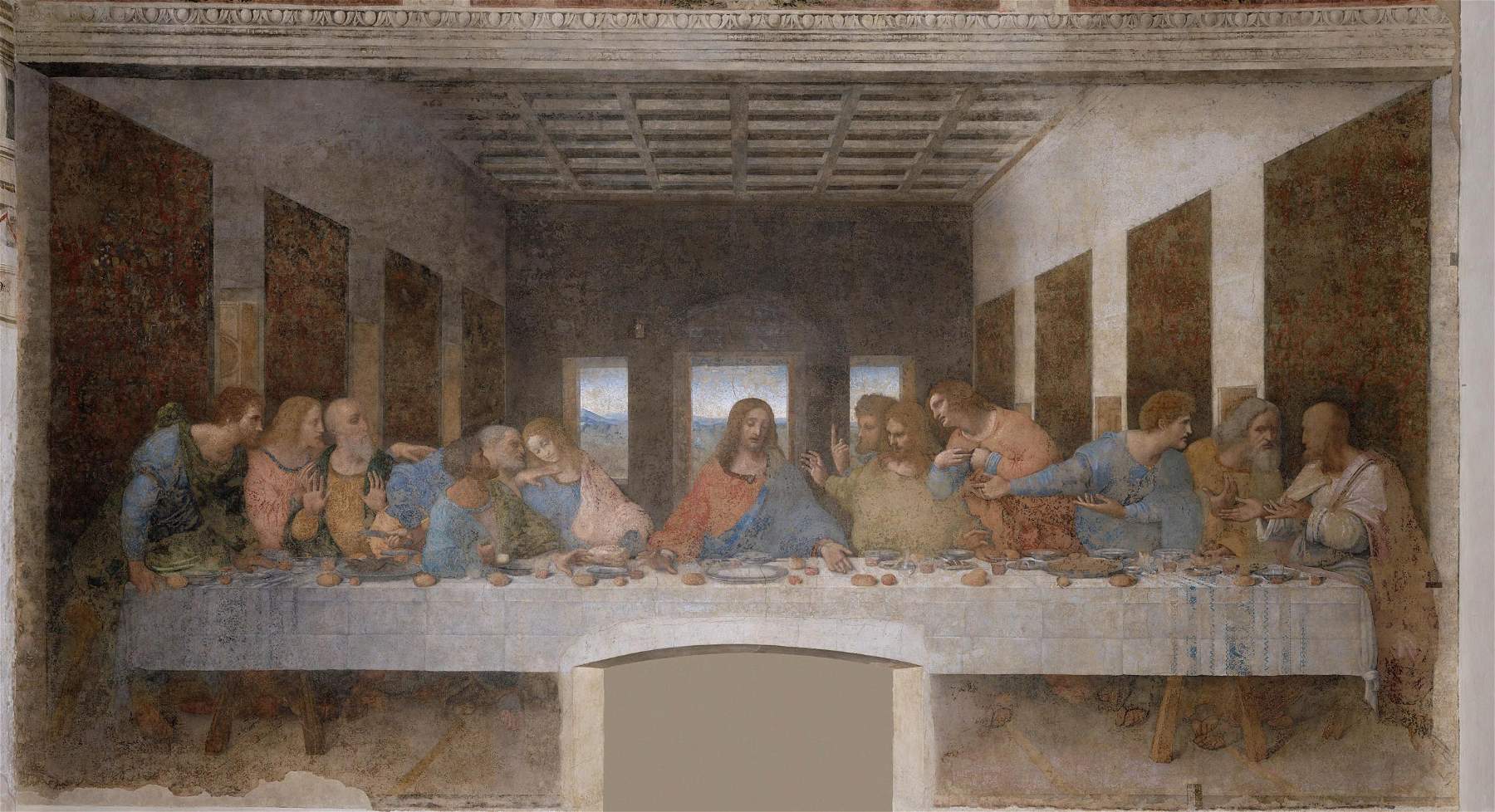 |
| Leonardo da Vinci, Last Supper (1493-1498; tempera on plaster, 460 x 880 cm; Milan, Santa Maria delle Grazie) |
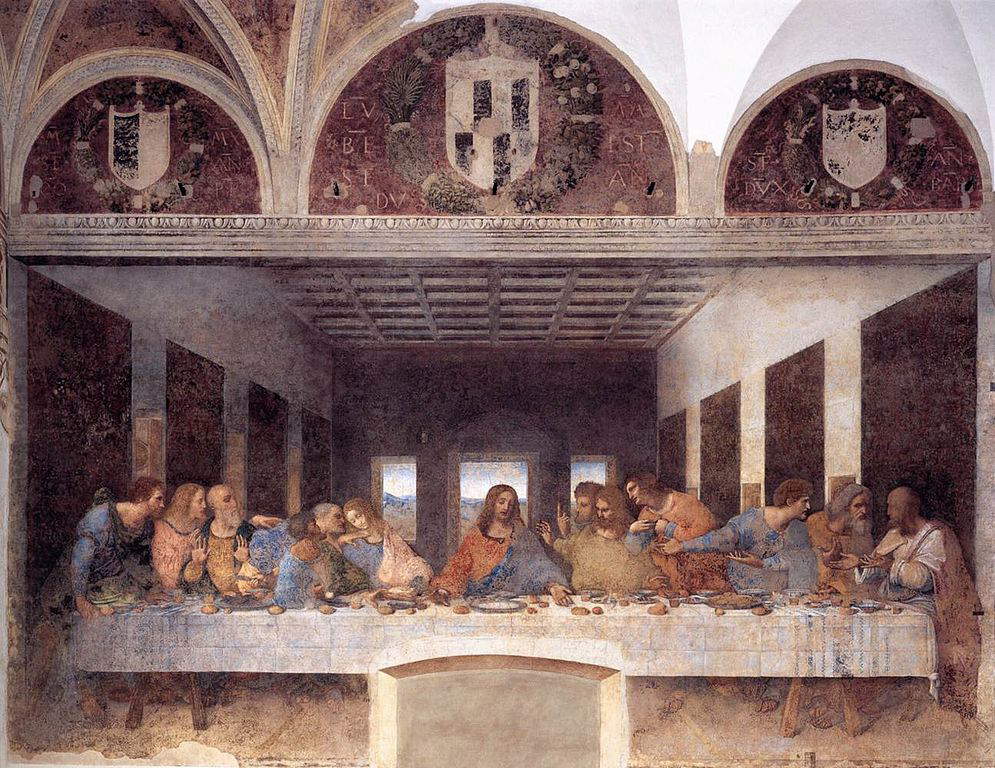 |
| The Last Supper with lunettes |
Reconstructing the history of the Last Supper is not easy because there is a lack of documents regarding the commission, and consequently we do not know the precise dates. The first certain date is 1488: dating from this year is the completion of the refectory of Santa Maria delle Grazie, the room that would have housed Leonardo da Vinci’s painting (we get the date from a seventeenth-century report by a friar, Girolamo Gattico, who compiles a Descrizione succinta e vera delle cose spettanti alla Chiesa e Convento di Santa Maria delle Grazie e di Santa Maria della Rosa e suo luogo). However, we do not know exactly when Leonardo began to design and paint his work, although critics mostly lean toward dating it between 1493 and 1494 as the starting dates (some elements, such as the dates appearing near some drawings that can be traced back to the studies for theLast Supper, and the fact that the last restoration allowed to shed light on a coat of arms that can be traced back to the commissioning of Gian Galeazzo, have led scholars to formulate this period as the one in which the realization of the masterpiece most likely began) and 1498 as the date of completion on which everyone agrees since, as mentioned above, theLast Supper must have already been complete in 1498, since Luca Pacioli, in the dedicatory letter of De Divina Proportione, describes it in detail. An important role in the events of the Last Supper is played by Ludovico il Moro (Milan, 1452 - Loches, 1508), who became duke in 1494 (although we are certain that the initial commissioner of the work was his predecessor, Gian Galeazzo Sforza, who died in 1494 at the age of only twenty-five: the Moor succeeded him). We know for certain that in the summer of 1497 Leonardo had yet to finish the work: it is dated June 29, 1497, in fact, a letter in which the Duke of Milan orders his secretary Marchesino Stanga to “solicitare Leonardo fiorentino perché finischa lopera del Refetorio delle Gratie principiata per attendere poy ad laltra fazada desso Refetorio,” where “l’altra fazada” is the wall that stands opposite the Last Supper and that in 1495 was painted with the Crucifixion by Giovanni Donato Montorfano (Milan, c. 1460 - c. 1502).
As for the date of its beginning, a great Leonardo scholar, Pietro Cesare Marani, has noted how many of the preparatory drawings for theLast Supper are to be dated to the early 1490s: after all, it is logical to think that once the room was completed in 1488, the need to decorate it immediately arose, and Leonardo probably began to study his work very early. Leonardo’s earliest designs for the lantern of Milan Cathedral date from 1487-1490, and it is interesting to note that the drawing (preserved at the Royal Collection) that is universally considered the first compositional sketch of theLast Supper appears, in the paper, along with some sketches that concern precisely the cathedral lantern. Other elements (e.g., the proximity of some studies for the heads of apostles to the famous Lady with an Ermine, painted in the late 1480s) would suggest a dating of the early reasoning for theLast Supper close to 1490.
To paint his Last Supper, Leonardo did not employ thefresco technique: in fact, the Last Supper was painted in tempera directly on the wall prepared with a plaster-based support. The artist wanted to avoid fresco so that he would not have to be constrained by the stringent rules compulsorily imposed by this technique, which calls for rapid execution “by the day” (i.e., on predetermined portions of paint to be finished in one work session) since the colors must be spread on the plaster while still fresh. Dry tempera would have allowed the painter not only to work more calmly and with greater precision, but also to lend itself to receiving details in oil to achieve more striking coloristic effects, a more pronounced luminosity: in short, dry tempera allowed Leonardo to be able to execute an extraordinary painting on a wall capable of engaging even more the relative. However, the technique chosen by the Tuscan artist had the disadvantage of making the painting very fragile, which explains the state of severe deterioration in which his contemporaries already saw it.
The work, therefore, must have had a very different effect at the time than it does today. Leonardo set his Last Supper within a large hall foreshortened in perspective in an illusionistic manner, with three large windows in the background opening onto the landscape (despite several attempts to try to identify it with a real place, we do not know what it corresponds to) and four large tapestries hanging on each side wall (now heavily compromised): above, a large coffered ceiling. All the elements of the architecture combine to create a geometric composition that aims to illusionistically break through the wall to artificially increase space, as if the Cenacle were an extension of the refectory. The length of the room is entirely occupied by the table covered by a white tablecloth, around which Jesus with the apostles are arranged, all on one side. Leonardo captures the moment when Jesus reveals the betrayal of one of the twelve: the disciples thus begin to manifest their disbelief, their astonishment, their dismay. They are arranged in groups of three around Jesus, who remains calm in the center: from the left we see Bartholomew, James the younger and Andrew, followed by Judas, Peter (who holds at his side a hand with a dagger, a clear reference to the episode of Christ’s capture that chronologically follows that of the supper: in those agitated moments, Pietrus will cut off an ear of Malchus, the servant of the high priest Caiaphas who came with other thugs to arrest Jesus), while to the left of Jesus we notice Thomas, James the Elder and Philip, and in the last group here appear Matthew, Judas Thaddeus and Simon the Canaanite.
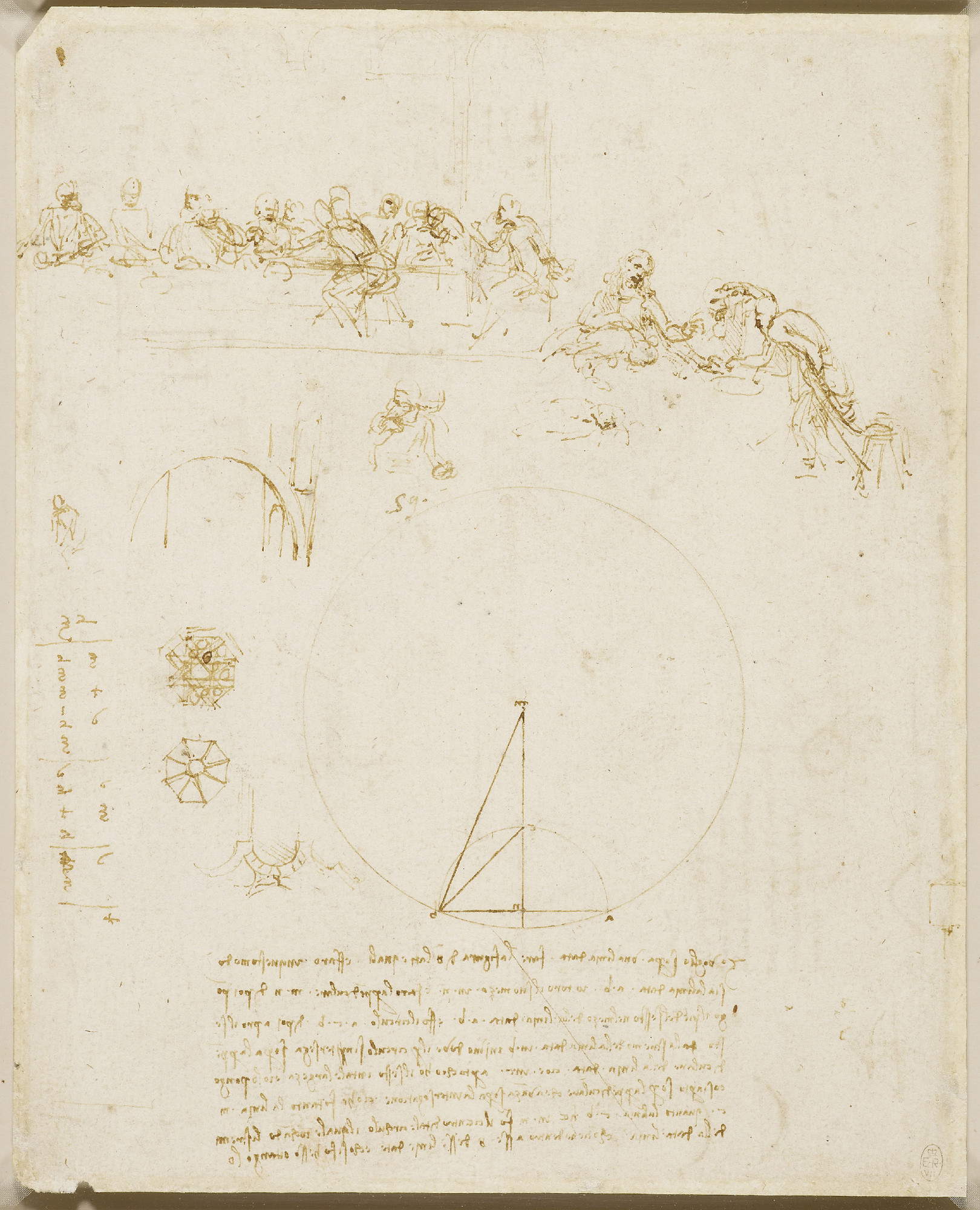 |
| Leonardo da Vinci, Study for the Last Supper and Architectural and Geometric Notes (c. 1490-1494; pen and ink, 260 x 210 mm; Windsor, The Royal Collection, inv. 912542) |
In painting his Last Supper, Leonardo could not help but draw on the great Florentine tradition: Domenico del Ghirlandaio (Florence, 1448 - 1494) had painted no less than three cenacles (that of All Saints and that of San Marco, both 1480, and that of the Badia di Passignano in Tavarnelle Val di Pesa, 1476), and before that Andrea del Castagno (Castagno di San Godenzo, c. 1421 - Florence, 1457), roughly between 1445 and c. 1450, had painted the Cenacolo di Sant’Apollonia, the first frescoed cenacle of the Renaissance, though not the first ever. Among the first to establish comparisons between Leonardo’s Last Supper and its predecessors was Heinrich Wölfflin, who drew a comparison with the Last Supper at St. Mark’s, noting that the main innovation introduced by Leonardo was his refined ability to depict the moods of the protagonists. But the differences are not limited to that: Leonardo, for example, abolishes the horseshoe table that Ghirlandaio had used instead as a solution for his 1480s cenacles, avoids depicting St. John asleep in the arms of Jesus as tradition wanted, and then again the great Da Vincian decides not to follow the most obvious topos of iconographic tradition, that is, the separation of Judas from the rest of the apostles (who in Florentine cenacles was painted alone and without a halo on the opposite side of the table from the one around which the diners sat) to emphasize his dimension as a traitor (Leonardo instead arranges him among the others: however, he was not the first to do so, for Beato Angelico did the same in theLast Supper painted on theArmadio degli Argenti, with the nimbus like everyone else: Leonardo, however, to emphasize the human and earthly dimension of his characters, eliminates the haloes). And again Wölfflin noted how Leonardo had revolutionized the relationship between space and figures: the most obvious index is the table of eight people that appears to us to be comfortable for thirteen, whereas in the cenacles of tradition each person had his or her own place, appropriately spaced from the others. And of course the arrangement of the table in space is also different: while in the earlier cenacles it is almost leaning against the wall, in the refectory of Santa Maria delle Grazie it appears to us instead in the center of a room that extends well beyond the shoulders of the protagonists.
Ghirlandaio’s works were, however, according to some scholars, an important basis for Leonardo, who, having studied in Florence, knew them very well. “For all the fame that Leonardo da Vinci’s supper has in the world,” wrote art historian Jan Lauts in 1943, “it is too often forgotten how much its classical solution found the ground prepared by Ghirlandaio in the representation of the refectory of the Convent of Ognissanti in Florence.” Then there is a further precedent to which Leonardo may have looked for the depiction of the room: it is the Trinity by Masaccio (San Giovanni Valdarno, 1401 - Rome, 1428) frescoed in Santa Maria Novella in Florence, which provided Leonardo with an important precedent for studying the perspective setting of the scene. Vinciano’s Last Supper, however, goes further, as Martin Kemp has noted: "Conceptually, Leonardo’s artifice takes naturalistic painting one step beyond Masaccio’s Trinity,“ the scholar writes. ”Masaccio’s work seems logical and is eminently logical, but this logic is inflexible. Leonardo’sLast Supper seems logical and trusts that we think it logical. But it is not. Its apparent reality contains a series of visual paradoxes. This system allowed him to achieve an extremely more varied range of expressive rhythms than would be achieved by a strictly observant Albertian perspective essay."
There is, finally, a precedent in Leonardo’s own work: it is not possible to read the Last Supp er without being aware of theAdoration of the Magi, the masterpiece now in the Uffizi that the artist from Vinci left unfinished (or that he deliberately suspended, as Gigetta Dalli Regoli has speculated): in theLast Supper we find, in fact, ideas that Leonardo already elaborated in the work for the monks of Scopeto, brought then, Marani wrote, to their highest degrees of compositional simplification precisely in the mural of Santa Maria delle Grazie. This can be seen by observing, for example, the characters who, in theAdoration, arrange themselves around the Madonna and Child, with gestures of amazement at the sacred epiphany. They are the first time when, in Leonardo’s painting, that poetics of the “motions of the soul” that distinguishes the most admired novelty of his Last Supper is outlined (although, again for Marani, the most “scientific” application of this poetics is to be found precisely in theAdoration).
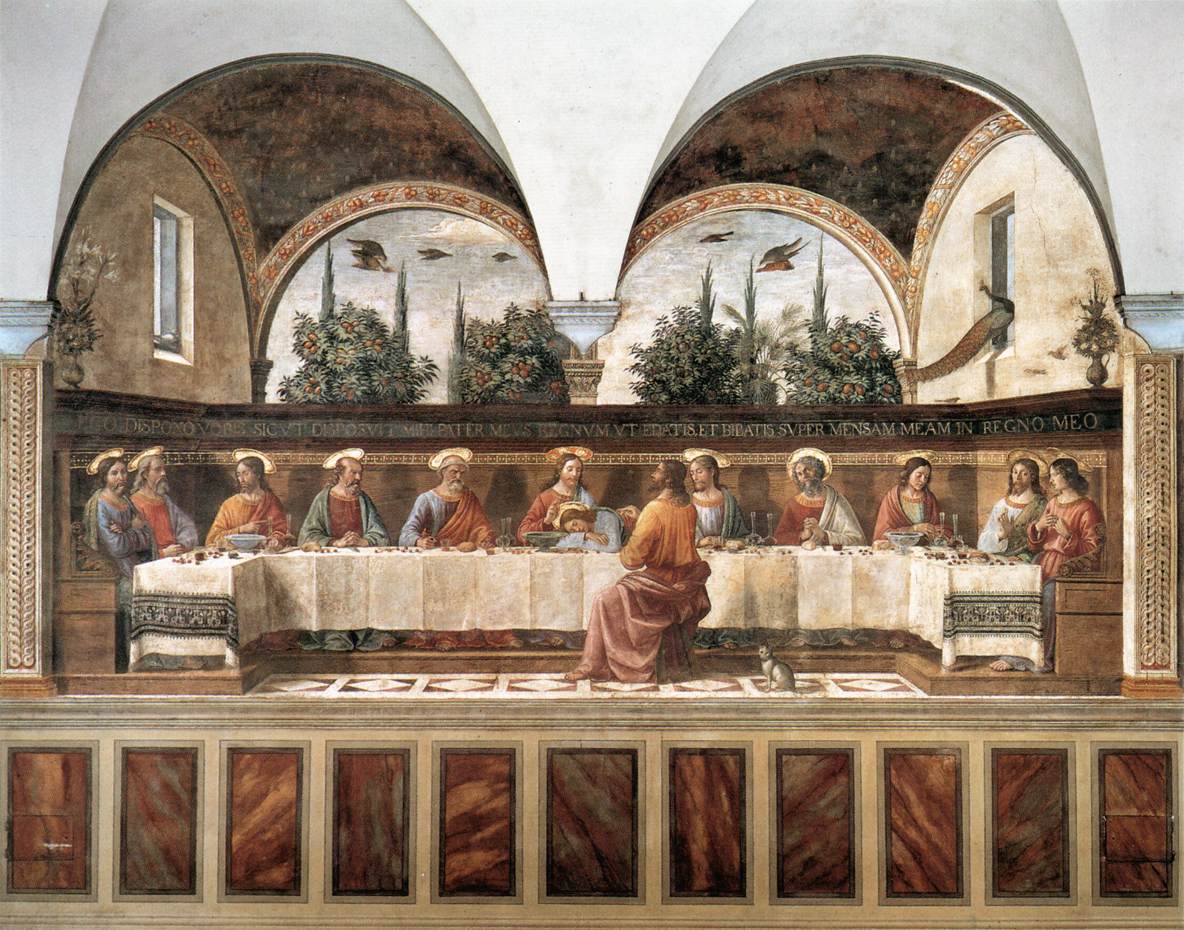 |
| Ghirlandaio, Cenacolo di San Marco (1480; fresco, 400 x 800 cm; Florence, Museo Nazionale di San Marco) |
 |
| Ghirlandaio, Cenacolo di Ognissanti (1480; fresco, 410 x 800 cm; Florence, Museo del Cenacolo di Ognissanti) |
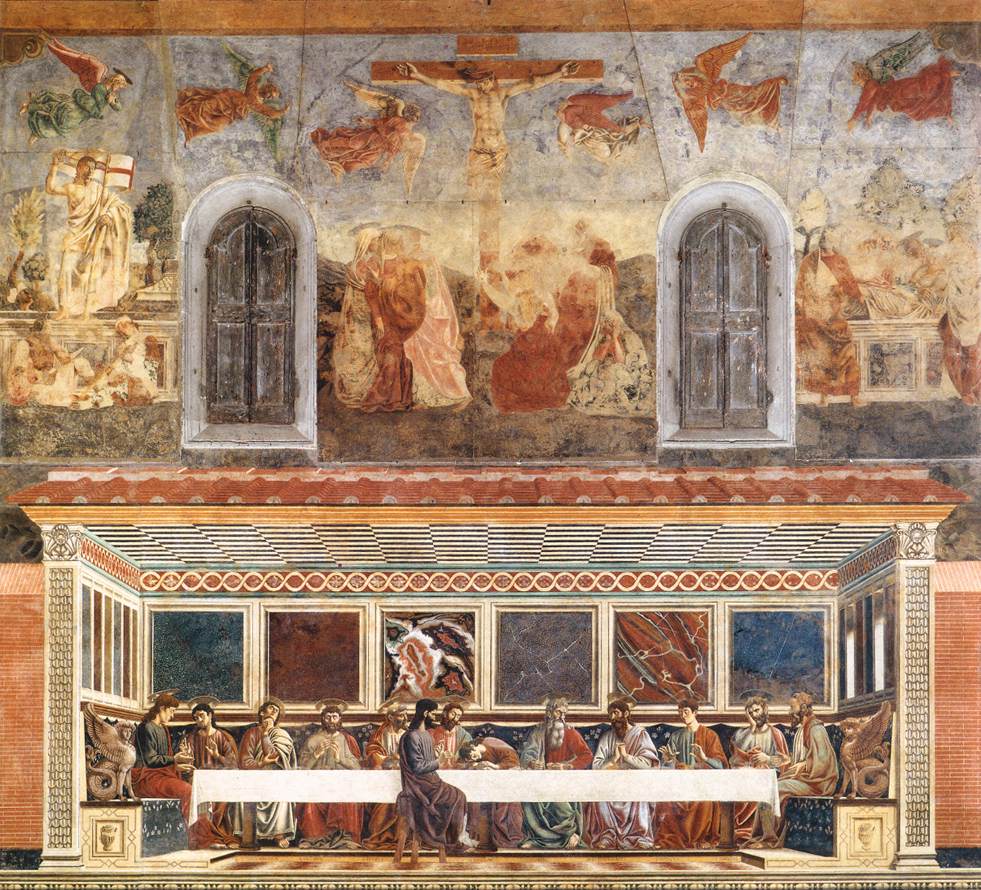 |
| Andrea del Castagno, Last Supper of Santa Apollonia (c. 1445-1450; fresco, 453 x 975 cm; Florence, Museo del Cenacolo di Santa Apollonia) |
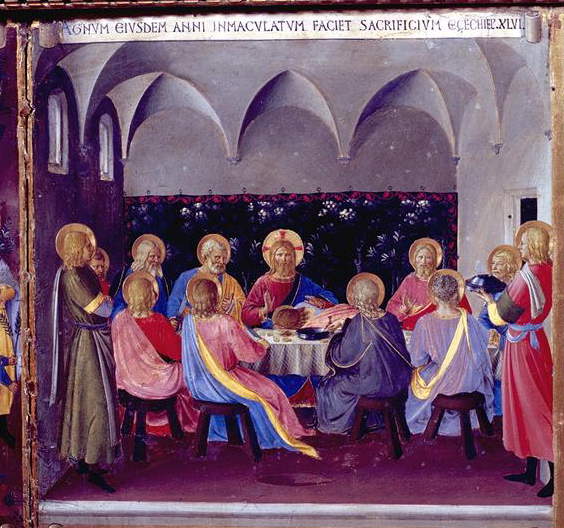 |
| Beato Angelico, Last Supper, from the Armadio degli Argenti (1451-1453; tempera on panel; Florence, Museo Nazionale di San Marco) |
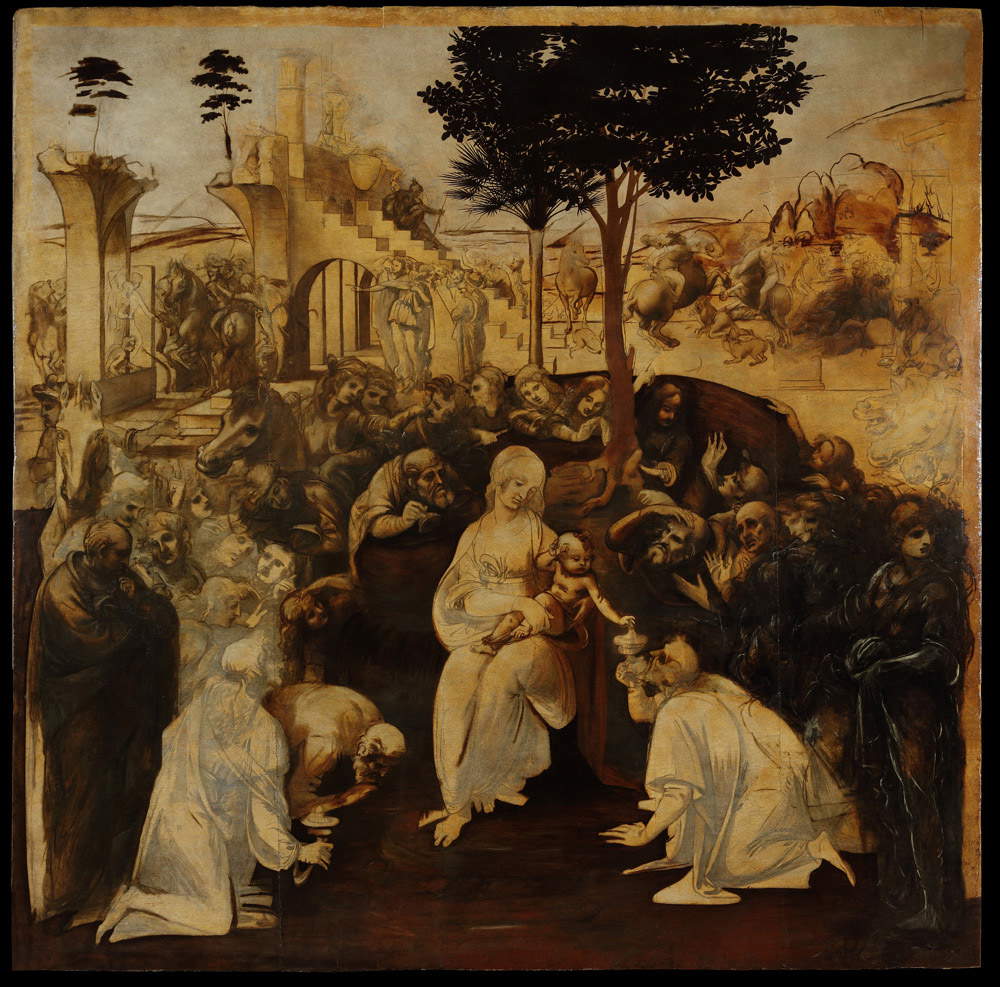 |
| Leonardo da Vinci, Adoration of the Magi (1481-1482; charcoal drawing, ink watercolor and oil on panel, 246 x 243 cm; Florence, Uffizi Gallery |
The Last Supper, then, continues a course of research that Leonardo da Vinci had begun with theAdoration of the Magi and which focused on what Leon Battista Alberti (Genoa, 1404 - Rome, 1472) in the vernacular version of his De Pictura had called the “movements of the soul,” an expression later rendered in some translations from Latin as “motions of the soul,” or the inner states of the characters depicted. “It pleases me in history,” Alberti wrote in De Pictura, “who admonishes and teaches us what is done therein, or calls with the hand to see, or with grim face and troubled eyes threatens that no one toward them should go, or demonstrates some danger or thing therein marvelous, or invites you to weep with them together or to laugh. And so whatever among them or thee the paintings do, all belong to adorn or teach thee history.” And again, “these movements of mind are known by the movements of the body. And we see how much one atristed, because estrigne care and thought besieges him, stand with his forces and feelings almost baleful, holding himself slow and sluggish in his pale and ill-supported memra. Thou shalt see to him whose brow is melancholy pressed, his cervix languid, To the whole his every member almost ragged and neglected falls. True, to him who is irate, for wrath incites the soul, however swollen with wrath in his eyes and face, and incensed with color, and every member of him, as much as fury.”
Leonardo adheres to Alberti’s science of the affections, summarizing it, in the Treatise on Painting, with a brief note: “You shall make the figures in such an act, which is soft to show what the figure has in the soul; otherwise your art will not be laudable.” The poetics of the motions of the soul calls for the movement of the body to express the mood of the protagonists: the mental disposition of the painted individuals is linked to its gestures, in short. And Leonardo devotes several of his notes to explain how actions match moods. In a note that appears on a folio of the Forster Codex II in the Victoria and Albert Museum in London, Leonardo himself provides a description of the apostles that conveys all the attention the artist intended to pay to the depiction of gestures in order to bring out the mental attitude of the characters: “One, who was drinking, leaves his knapsack in his site, and turns his head towards the proposer. Another weaves the fingers of his hands together, and with stiff lashes turns to his companion; the other, with open hands, shows the palms of those, and raises his shoulder towards his ears, and makes the mouth of wonder. Another speaks in the ear to the other, and the one who hears him turns towards him, and hands him his ears, holding out a knife in one hand and bread in the other, half divided by said knife. The other, in turning, holding a knife in his hand, pours with such hand a knapsack over the table. The other lays his hands on top of the table and looks, the other blows into the morsel, the other bends down to see the proposer, and makes shadow with his hand to his eyes, the other pulls himself addressed to that one who bends down, and sees the proposer between ’l wall and ’l stooped.”
And the range of feelings that Leonardo paints on the faces and in the gestures of his apostles is the most varied. One can read the anger on the faces of Peter and James the elder, Thomas looks at Jesus with a questioning air, there is consternation in the face of Philip, and then again the dismay of Andrew, the amazement of Matthew, Simon the Canaanite and Judas Thaddeus who argue animatedly among themselves, the surprise of Bartholomew who snaps to his feet leaning his hands on the table, the disbelief of James the younger, the feigned astonishment of Judas who clutches the bag of thirty denarii with his right hand, the sadness of John. Faced with an event such as Jesus’ announcement, and knowing from his mouth that a traitor lurks among the twelve, the apostles cannot remain impassive: their reaction is sincere, and Leonardo takes care to convey it to the concerning, experiencing a continuity of actions and feelings that no one before him had managed to express. The “magic” of the “motions of the soul” is the key to understanding theLast Supper, scholar Valentina Ferrari has written. The study of feelings could not be neglected by an artist who had devoted his entire career to the study of nature: such a timely and precise rendering of the “motions of the soul” also stemmed from a careful observation of reality and life, which led the painter to abandon the rigid and stereotyped gestures of tradition in order to try something new, something that, after reaching its zenith in theAdoration of the Magi, in the Last Supper takes the form of a kind of poetic manifesto.
The rendering of the “motions of the soul” then has important conceptual implications: Leonardo, according to the principle ofut pictura poesis, regarded painting as mute poetry, and poetry as blind painting, “and luna and laltra go imitating nature as much as is possible to their powers, and by luna and laltra many moral customs can be demonstrated” (so he wrote again in the Treatise on Painting). However, in his opinion, painting was able to communicate the motions of the soul more immediately, in a more universal way. And for this reason, too, Leonardo insisted on the importance of exercising one’s imaginative capacity by continuously studying, trying, experimenting.
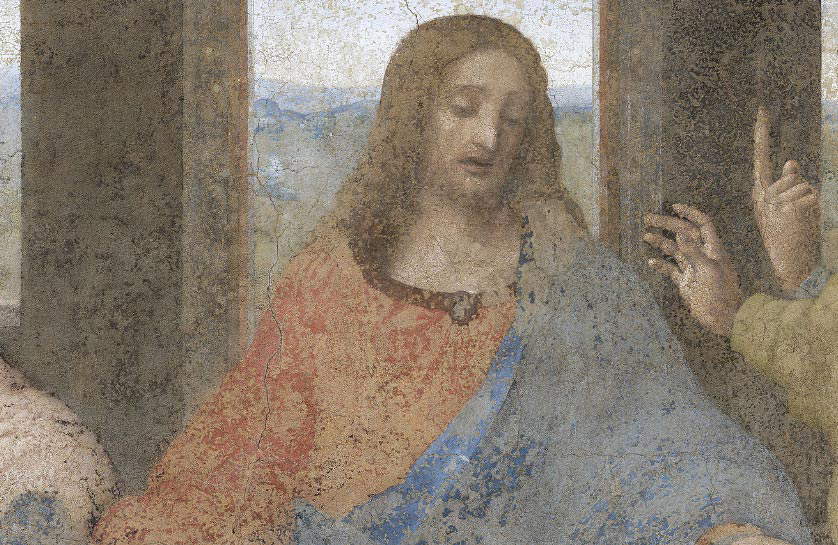 |
| Leonardo da Vinci, Last Supper, detail |
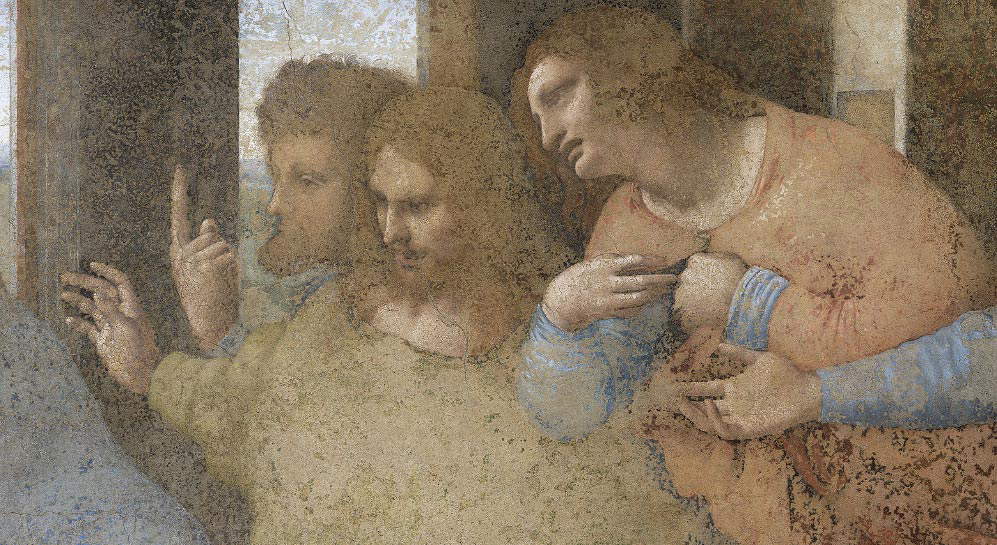 |
| Leonardo da Vinci, Last Supper, detail |
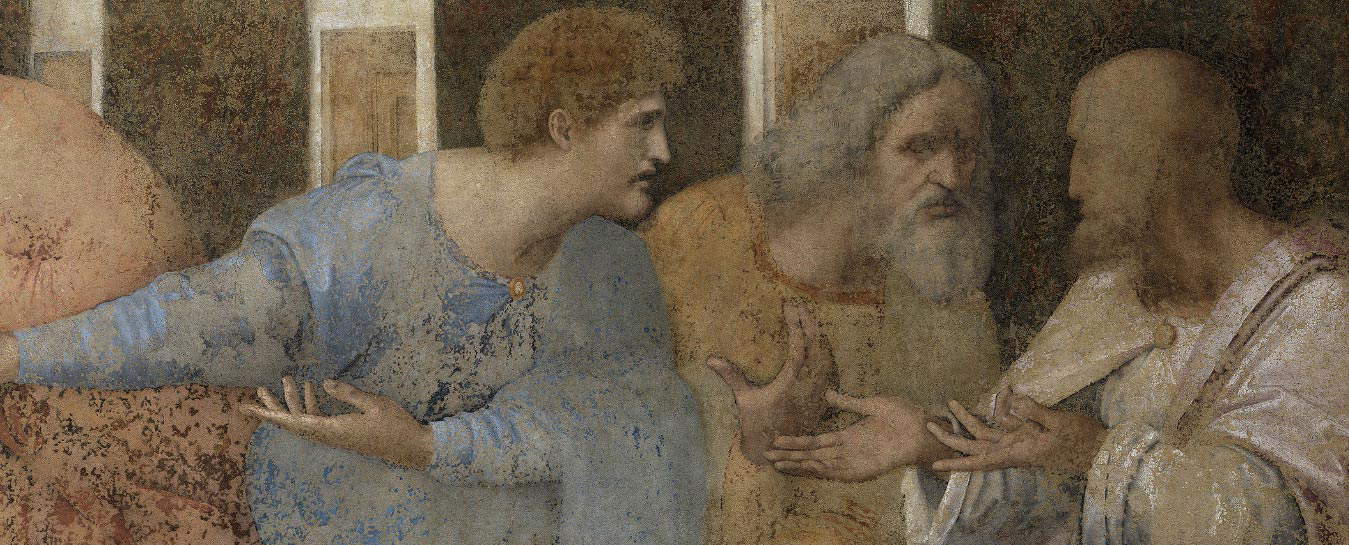 |
| Leonardo da Vinci, Last Supper, detail |
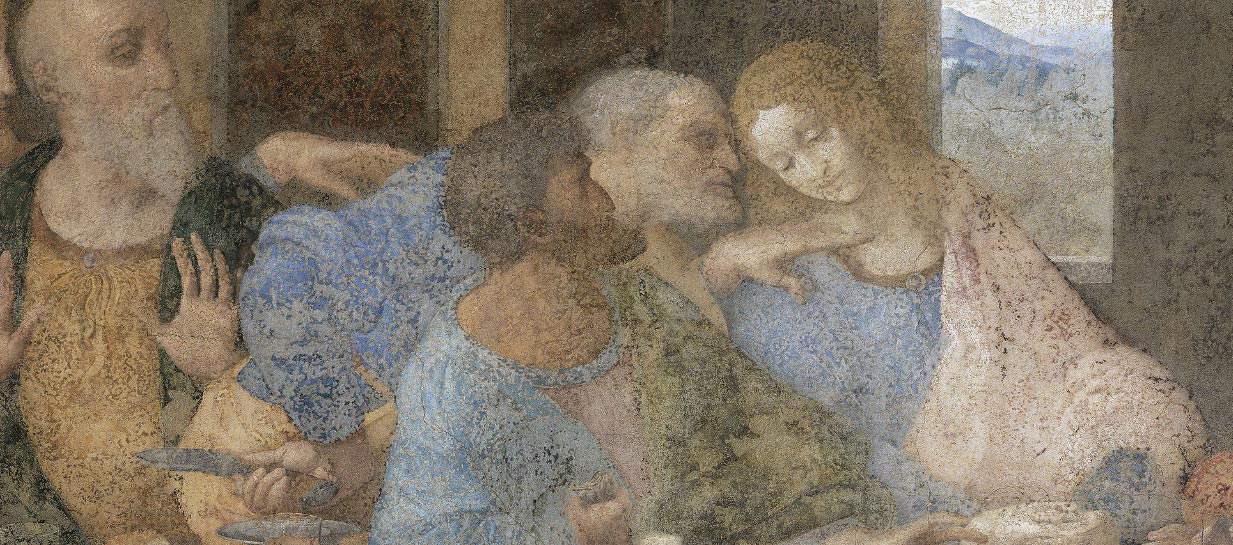 |
| Leonardo da Vinci, Last Supper, detail |
 |
| Leonardo da Vinci, Last Supper, detail |
 |
| Leonardo da Vinci, Last Supper, detail |
We also know Leonardo da Vinci’s ideas from the preparatory drawings for theLast Supper that have survived. Stefano L’Occaso, in the exhibition catalog Leonardo da Vinci. First Ideas for the Last Supper, held at the Last Supper in 2019, explained why the drawings are so important: they convey the structure of the artist’s creative journey, shed light on his continuous conceptual experimentation, allow us to understand the degree of attention Leonardo paid to every single detail of his composition, and enable us to look at theLast Supper as a kind of theatrical performance, caught in a moment of vivid spontaneity. There are, however, not many drawings referable to theLast Supper that can be attributed to Leonardo: seven are preserved in the Royal Library in Windsor, one at the Département des Arts Graphiques in the Louvre, one at the Istituto Nazionale per la Grafica in Rome, one at the Albertina in Vienna, and three at the Gallerie dell’Accademia in Venice.
Some of the sheets are interesting for understanding how Leonardo solved one of the main problems of the Last Supper, as L’Occaso explains again well: how to give unity to thirteen figures around a table and painted only from the chest up? Leonardo, the art historian explains, found the solution to the problem by expanding the scale of the figures and scaling them in depth, on staggered planes, in contrast to what his predecessors had done in other cenacles in which the apostles are placed side by side in a paratactic manner. A Windsor sheet (912542, what is believed to be the first compositional study of the painting) and one from Venice (254) study precisely the planes of the characters. Then there are others in which expressions and light are studied: this is the case, for example, with Windsor’s 912552, in which the artist focuses on St. James the Elder, and where we see, moreover, that the hand has a different position than the one the apostle will later have on the finished mural painting (we see it in the act of retracting from the table, as if James feels a certain revulsion at the moment when Jesus says that the one who dips his hand in his own plate is the one who betrays him: evidently the position of the limb was intended to give visual evidence to Christ’s words). Also at Windsor, drawing 912546 is a splendid study of the drapery of St. Peter’s arm, lit from the left. Then there are meticulous studies of the pose of the hands, such as 140 in the Gallerie dell’Accademia in Venice or 915243 in Windsor.
Several critics (such as L’Occaso, Marani, Carlo Pedretti and Michela Palazzo) do not believe that Leonardo made a preparatory cartoon. No traces of charcoal dust (the main clue that would have indicated a possible transposition from cartoon) were found on the wall on which theLast Supper is painted: we cannot exclude the possibility, as Michela Palazzo explained, that Leonardo made preliminary sketches, but at the moment we do not know of any. During the last restoration, Palazzo further explained, however, traces of graphic marks emerged on the plaster, especially on the lunettes, and fragmentary traces of the sinopia were also found in the dinner scene. Palazzo suggests that Leonardo probably sketched out a first draft of the idea before moving on to draft the preparation (an idea supported by the fact that traces of the engravings that were used to establish the dimensions of the forms in the preliminary stages were also found).
 |
| Leonardo da Vinci, The Head of St. James and Architectural Studies (c. 1495; red chalk, pen and ink, 252 x 172 mm; Windsor, Royal Collection, inv. 912552) |
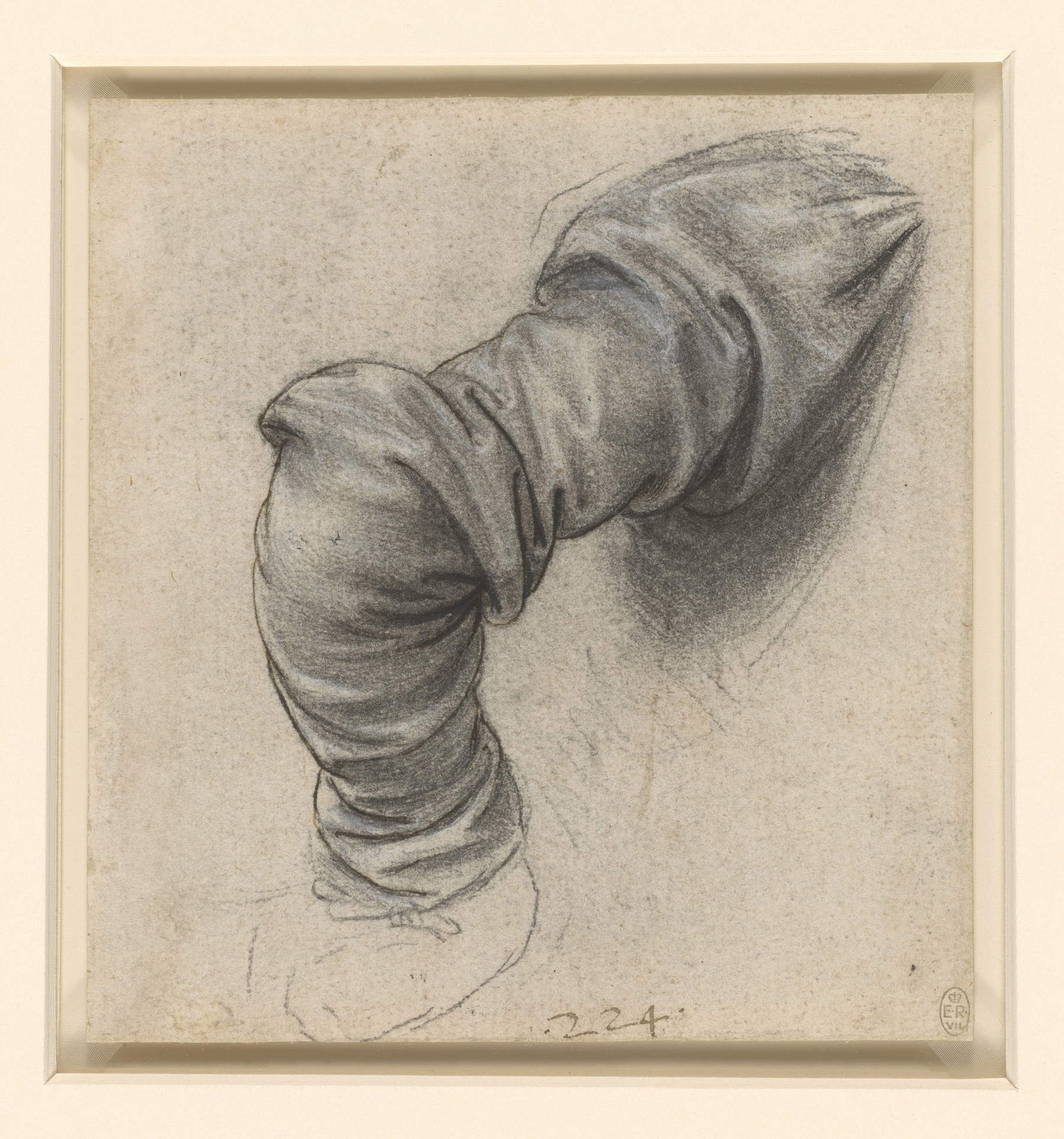 |
| Leonardo da Vinci, The Right Arm of St. Peter (c. 1495; black chalk with white highlights, pen and ink, 166 x 155 mm; Windsor, Royal Collection, inv. 912546) |
 |
| Leonardo da Vinci, The Hands of Saint John (c. 1495; black chalk, 117 x 152 mm; Windsor, Royal Collection, inv. 9125432) |
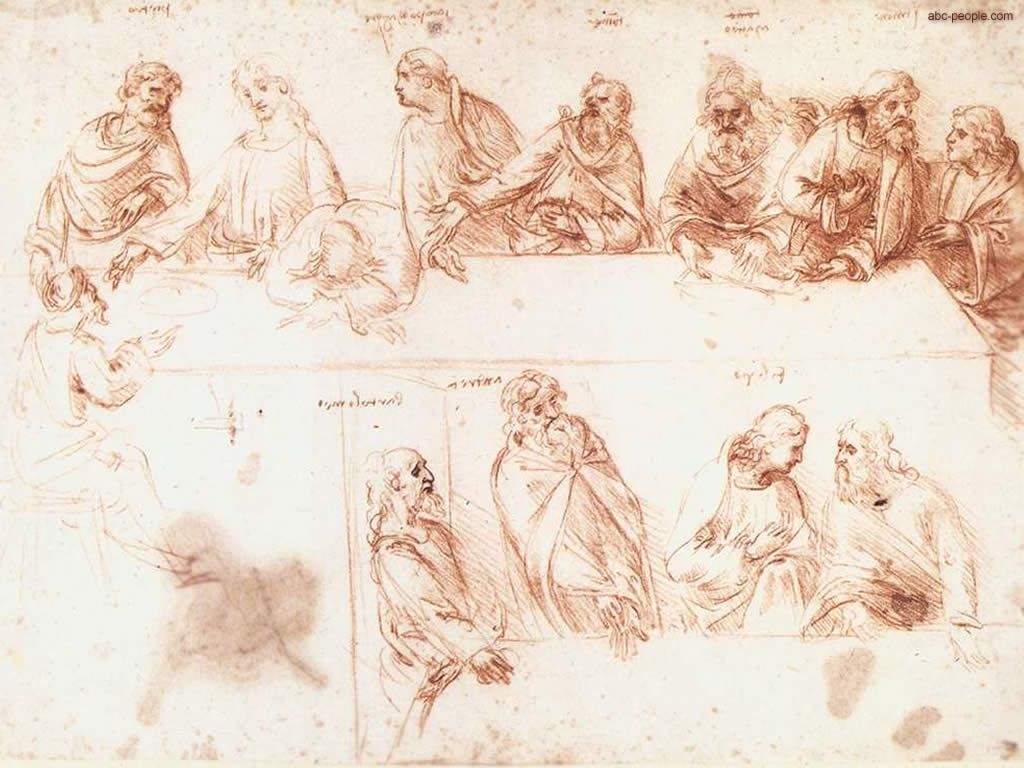 |
| Leonardo da Vinci (?), Studies for the Last Supper (c. 1495; Venice, Gallerie dell’Accademia, inv. 254) |
Leonardo’s Last Supp er experienced an inexorable process of rapid degradation already shortly after its completion. Already Giorgio Vasari, in the Giuntina edition of the Lives (of 1568) reported on a visit he made in 1566, during which he had been able to ascertain the poor state of the painting, “having seen this year 1566 in Milan the original by Lionardo so badly conducted,” Vasari wrote, “that one can no longer see it except for a dazzled stain; wherefore the pity of this good father always bore witness to this part of Lionardo’s virtue.” And by the end of the 19th century the damage seemed so irreparable that Gabriele d’Annunzio, after one of his visits to the Upper Room, dedicated to it the ode Per la morte di un capolavoro, included in the 1903 collection Elettra. The work had already undergone restoration: the first one recorded in the sources dates back to 1725, although theLast Supper was probably the subject of even earlier interventions. As early as the seventeenth century, as the official record of the Ministry of Cultural Heritage attests, the work was probably subjected to a removal of dust fixed to water condensation and a dark paint job to repair a gap in the upper part of the ceiling. In 1725, the painter Michelangelo Bellotti intervened with an aggressive washing with caustic soda and then repainted the work to mitigate its dulling (eighteenth-century methods were certainly not those of today). Other interventions followed in 1775, when Giuseppe Mazza carried out a maintenance of Bellotti’s restoration, as well as some retouching; in 1821, when Stefano Barezzi repaired some gaps and removed the previous repainting to proceed with new additions; between 1903 and 1908, with new, light reparations of the gaps carried out in watercolor by Luigi Cavenaghi; in 1924, when Oreste Silvestri injected a fixative based on resin and mastic in petroleum essence in order to consolidate the color and performed new reintegrations; finally, between 1947 and 1954, when Mauro Pelliccioli removed the previous restorations using turpentine, alcohol and scalpel. Moreover, the Da Vinci Last Supper had miraculously escaped the bombings of World War II.
Despite numerous interventions, by 1977 theLast Supper ’s state of preservation was far from optimal, and there were also problems of a static nature, which had caused serious damage to the wall and, consequently, to the painting. As stated in the ministerial record, “the thrust exerted on the wall by the vault of the room rebuilt after the bombings and the modifications made on the rooms adjacent to the room, raised concerns of a static order from which the determination of a worrying state of cracking and from deformations of the masonry, combined with the incontestable deterioration of the pictorial film due to Leonardo’s own technique of execution.” The surface of the painting, in particular, was blurred, dirty, altered due to the many repaintings, and therefore much tampered with, and with color falls due to static problems. It was therefore decided for a new restoration, the last, entrusted to the restorer Pinin Brambilla Barcilon (Monza, 1925 - Milan, 2020).
 |
| Pinin Brambilla Barcilon in front of the Last Supper. |
Brambilla Barcilon was the author of a long restoration, which lasted until 1999, and which gave us back the image of theLast Supper as close as possible to the Leonardo original. The restorer from Monza removed all the layers that had covered the original pictorial film (varnishes and repainting, with removal by means of a solvent designed to be able to conduct a controlled and targeted action), not without several difficulties, given also the tenacity that the repainting presented in some places (so much so that for some areas it was impossible to remove the remnants of the ancient interventions). Another difficulty was also given by the different materials that the restorers had used in the various areas of the painting, which is why different methodologies had to be chosen for even close areas of the work. After the removal of the stratifications, it was necessary to consolidate the original film, which was finally rediscovered: a very fragile film, uncovered centimeter by centimeter with a decidedly meticulous work, but one that well restored the intensity of Leonardo’s masterpiece. The Rai’s display cases preserve a video that captures Federico Zeri ’s commentary during the ongoing restoration in 1995: “It is striking the result of this cleaning that has uncovered details of incredible subtlety,” Zeri stated. “For example, the tablecloth, with the folds, with the embroidery, the objects on the table, the pewter plates, the wine glasses, the bread, the fruit. And then especially the language of the faces, this kind of mute language, also expressed by the hands. [...] We used to see the result of endless layers of repainting, even often coarse repainting, making the part yet to be cleaned practically unreadable. Now we see that what was called Leonardo’s Last Supper was the result of those who had put their hands through the centuries. It has completely changed the cleaned part-it is amazing.”
Following the latest restoration, the painting is under constant scrutiny to prevent further deterioration. The refectory of Santa Maria delle Grazie has since been under a strict regime of restricted visits (one can enter the Upper Room by reservation and can stay in the room only for a limited period of time), the flow of air inside is controlled, and environmental parameters (temperature, humidity and so on) are monitored. Even the path to get to the room is specially designed to filter the air coming in from outside, so that the painting is not affected. And so that, therefore, it can still live a very long time.
Warning: the translation into English of the original Italian article was created using automatic tools. We undertake to review all articles, but we do not guarantee the total absence of inaccuracies in the translation due to the program. You can find the original by clicking on the ITA button. If you find any mistake,please contact us.